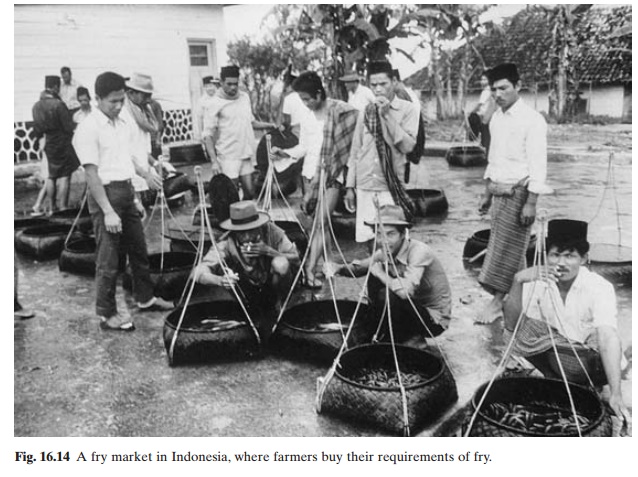Chapter: Aquaculture Principles and Practices: Carps
Culture systems in Aquaculture
Culture systems
As a group, carp appear to be especially suited for pond culture, although
other systems of culture, in cages and rice fields and stocking in open waters,
are carried out experimentally or commercially on a small scale. Small ponds or
pools with running water have been used in countries like Japan and Indonesia,
for intensive culture of common carp, but most of present-day aquaculture is
carried out in stagnant or semi-stagnant ponds. As carps feed on low trophic
levels, it is possible to produce most of the food needed through fertilizing
ponds and this greatly reduces feed costs. Further, different types of organic
manures and farm wastes can be used as fertilizers, and this contributes to the
farm economy. Species like the grass carp that feeds on macrovegetation can be
fed at little cost with land grass and most types of aquatic vegetation, in a
fresh or decayed state. Because of these advantages and the comparative ease
with which they can be reared in small and large farms, including village
ponds, carps are generally perceived as low-valued fish, suited for large-scale
production to feed poor communities in rural areas. This is not the case in all
areas. In countries or regions where there is a distinct consumer preference
for carps, some of the species sell at comparatively high prices – for example
the grass carp in China, rohu in Eastern India and the common carp in Israel,
Eastern Europe and some West European countries.
Though all the carps used in aquaculture are fresh-water species, they
can tolerate salinities up to 10–11ppt, and sometimes even grow better at salinities
of about 5ppt.
As will be discussed the carps, particularly the Chinese and Indian carps and common carp, have been widely used in their native countries for open-water stocking. Some of the other Asian countries have also transplanted them in open waters. Common carp has been the main species for ricefield fish culture, but other species like tilapia have replaced them in recent years as the major species in some countries.
Most of the recorded cases of cage culture of carps are experimental in nature,
but there is a common traditional practice of growing them in bamboo cages in
Indonesia and small-scale cage farming is practised in Chinese lakes. In
Indonesia, cages are installed on the bottom of canals conveying large amounts
of domestic wastes (fig. 16.13). The fish obtain their food mainly from the
bottom of the canals, where chironomid larvae and other benthic organisms
abound. The farmer may introduce limited quantities of supplemental feeds.
Obviously this type of culture differs very considerably from the present-day
culture of fish in floating cages, based mainly on artificial feeding. Such
practice appears to be adopted only in Japan for growing carp in lakes,
reservoirs and large irrigation or farm ponds.

Carps are grown in a wide range of pond facilities, ranging from small
undrained village ponds to large, well-laid-out pond farms several hectares in
area. Most such farms have a series
of nursery and rearing ponds of different sizes. Rearing ponds are
comparatively much larger in Eastern Europe than in Asia. If breeding is done
on the farm, brood ponds (and, in the case of common carp, spawning ponds) may
be included in the farm layout. Many farmers purchase their fry from commercial
fry producers and so require only nursery ponds in their farms (fig. 16.14).

Although monoculture of the common carp is practised by many farmers, the Chinese and Indian major carps are almost always grown in polyculture systems. As mentioned earlier, several combinations of Chinese and/or Indian carps and the common carp are used very widely. The crucian carp (Carassius auratus) and the wuchang fish (Megalobrama ambly-cephala) are often added to this combination inChina. However, each combination is based on one or two species (grass, black or silver carp) as the major elements and the others are only complements to the major species. Polyculture of common carp, silver carp, tilapia and the grey mullet (Mugil cephalus) in fresh-water ponds has become a common practice in Israel. This combination is valuable because of the control of filamentous algae by the common carps, the consumption of planktonic algal blooms by the silver carp and consequent improvement of oxygen regime, and the feeding on the organic ooze at the pond bottom by the tilapia. More importantly, such polyculture has helped considerably to overcome problems created by limits on carp production and to diversify and increase overall pond fish production.
Related Topics